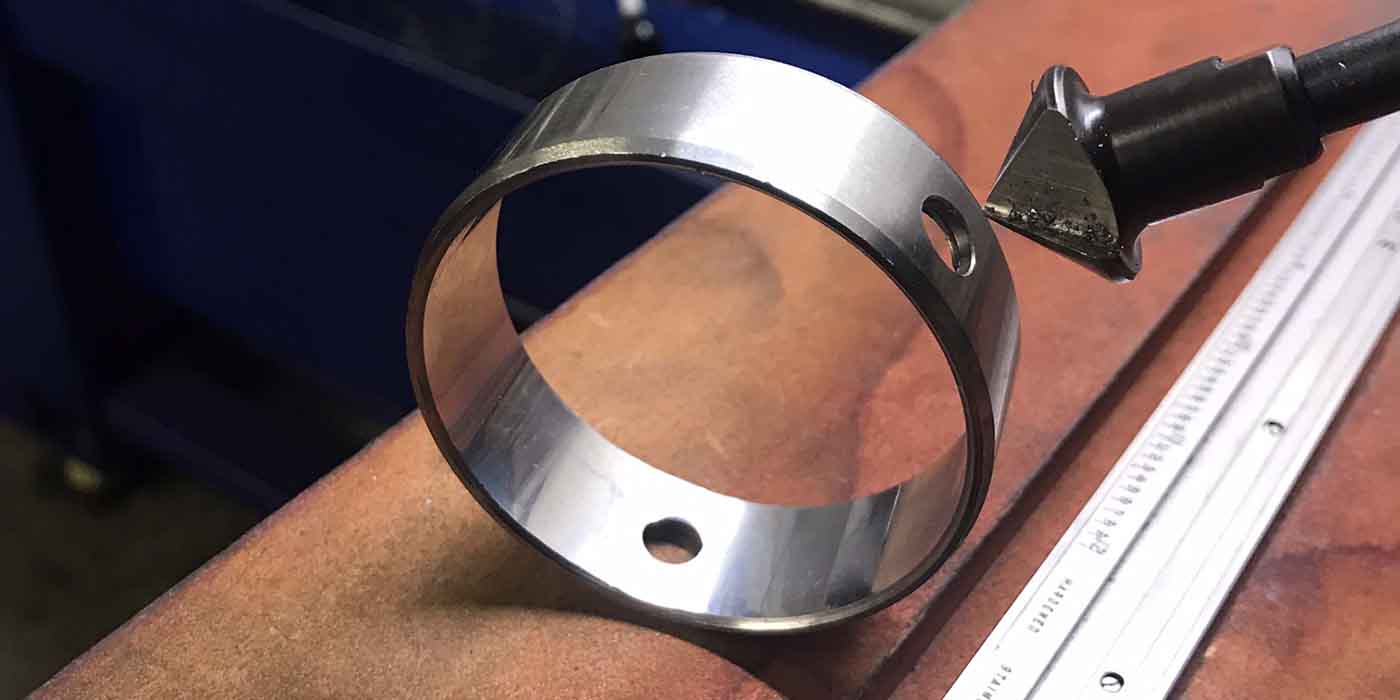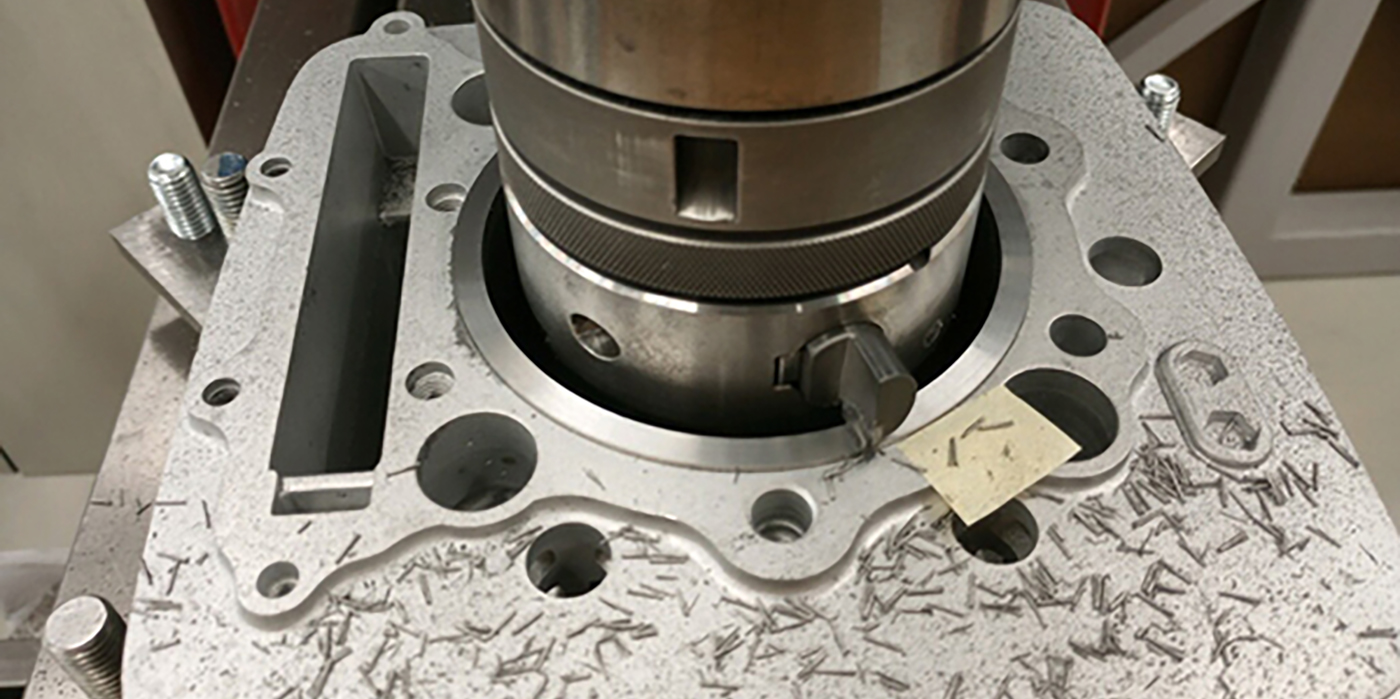Safe Valve Spring Break-In
Most engine builders are well aware of the fact that high performance valve springs should be compressed to coil bind through several cycles before being installed. The problem with this procedure is that it can be time consuming, costly and even dangerous.
It is time consuming if each spring is compressed in a valve spring pressure tester and costly due to the fact that compressing many valve springs through several cycles accelerates wear and reduces the life span of the spring tester. Compressing springs in a vise or arbor press can be dangerous if the compressed spring escapes, thus becoming a projectile careening throughout the shop.
We have solved these problems by making a fixture which holds four valve springs and is compressed in our 20 ton shop press. The fixture is made of two 3? x 6? aluminum plates with spring seats machined into them. Each of the four spring seats has a .375? diameter steel rod through the center to retain the spring if one should become dislodged during the procedure. Each steel rod is attached to the bottom plate and has enough clearance to move through the top plate. A recess is also machined into the top plate to accommodate the shaft on the shop press.
Bill Riordan
Riordan Engineering
Twin Lake, MI
Extra Grip for Your Phillips Head Screwdriver
Have you ever had a Phillips head screw that was kind of worn out and slipping as you tried to unscrew it? Take some valve lapping compound and put it on the tip of the screwdriver. This will give you some extra “bite” as you turn it.
Jeff "Beezer" Beseth
Beezer Built, Inc.
Newtown Square, PA
Put a Trash Compactor in Your Shop
We all know how fast a trash can fills up with bearings, piston rings, paper and small cardboard boxes. Install a trash compactor in your assembly area and you’ll be amazed how much it will hold before emptying, and it will cut down on the time needed to empty trash.
Popular in upscale kitchens years ago, some compactors were used very little, or not at all. They can be found in the ads of local papers sometimes for little or nothing, usually after kitchen remodels. They take up little space, fit under benches, and run on 110 volts. As a side benefit, if you have a recycling service, the contents can be picked up for nothing, cutting your waste costs.
Lewis Barr
LA Engineering
Glen Allen, VA
Connecting Rod Bore Standards
To help me quickly set up my rod machine bore gauge for common connecting rod reconditioning I machine up some “standards” from good old rod cores. I size most to mid-spec and then paint the rod with a color code to help me quickly identify it and keep it from getting confused with the set I am working on. By machining a rod big end to the size I want, I can use it time and again to adjust my bore gauge to the proper size before dong a run of that particular rod. This saves me time and money.
Terry Kiehnau
Terry’s Engines
Green Bay, WI
How to Combine Work and Play
The next time you attend a car show, cruise night or “show ’n shine,” invite some enthusiasts to visit your shop. There is no better way to increase your business than by befriending custom car enthusiasts.
This tip requires you to print a business card that you’ll hand out at custom car events. The card should include a free offer such as: FREE OIL ADDITIVE or FREE BENCH RACING or FREE COFFEE printed on one side of the card with your company information listed on the other. It should also invite the car owner to your shop to receive the offer and while he is there it’s a great time for a tour, a FREE quote and a cup of coffee (or two). If space permits, include a list of services specific to your target audience. And keep your coffee pot filled with premium roast!
Steve Rich
Sterling Bearing, Inc.
Kansas City, MO
Manufacturer Shop Solution: Which Piston Rings to Use 7.3L Ford V8 Diesels?
Your customer has a 1994 Ford 7.3L turbocharged diesel powered truck and needs piston rings. No problem? Not so fast! It will take asking more questions and perhaps examining and measuring some components to identify the correct rings.
 Between 1988 and 2003 Ford produced three versions of diesel V8 engines, all with the same engine displacement of 7.3 Liters. All of these engines had the same 4.110? cylinder bore. In 1994 all three engines were available. Each of these engines used a unique ring pack. The engines, their identifying characteristics and the rings for each are listed below.
Between 1988 and 2003 Ford produced three versions of diesel V8 engines, all with the same engine displacement of 7.3 Liters. All of these engines had the same 4.110? cylinder bore. In 1994 all three engines were available. Each of these engines used a unique ring pack. The engines, their identifying characteristics and the rings for each are listed below.
The 1988-94 naturally aspirated engines were great candidates for turbocharging. Companies such as ATS, Banks and Hypermax have sold a large quantity of turbo kits to enhance the performance of these engines. However, this can add to the confusion when it comes to overhaul time as to whether the engine was originally turbocharged or it was converted. Refer to the chart below to make sure you are ordering the correct piston rings and other replacement parts for the engine you are working on.
Ray Falkenrath
Director of Product Development
Hastings Manufacturing Company
Hastings, MI
Engine Builder Shop Solutions is sponsored by Engine Pro,
a group of 9 engine parts specialist WDs in the U.S., and one in Australia, operating 35 branch
locations serving engine builders/rebuilders across the U.S and Australia. Authors of Shop
Solutions published in each issue of Engine Builder Magazine are awarded a prepaid $100 Visa gift card. Entries will be chosen by
the staff of Engine Builder Magazine and the Engine Pro Technical
Committee.
To submit a Shop Solution simply mail your entry
to Engine Builder Magazine, Shop Solutions, 3550 Embassy Parkway,
Akron, OH 44333; or email to Shop [email protected]. Shop
Solutions may also be emailed to [email protected].
You must include
your name, shop name, shop address and shop telephone number. Submitted
Shop Solutions not published will be kept on file and reevaluated for
publication with each month’s new entries. If you include your email
address you will be emailed notification of publication if your Shop
Solution is chosen.













